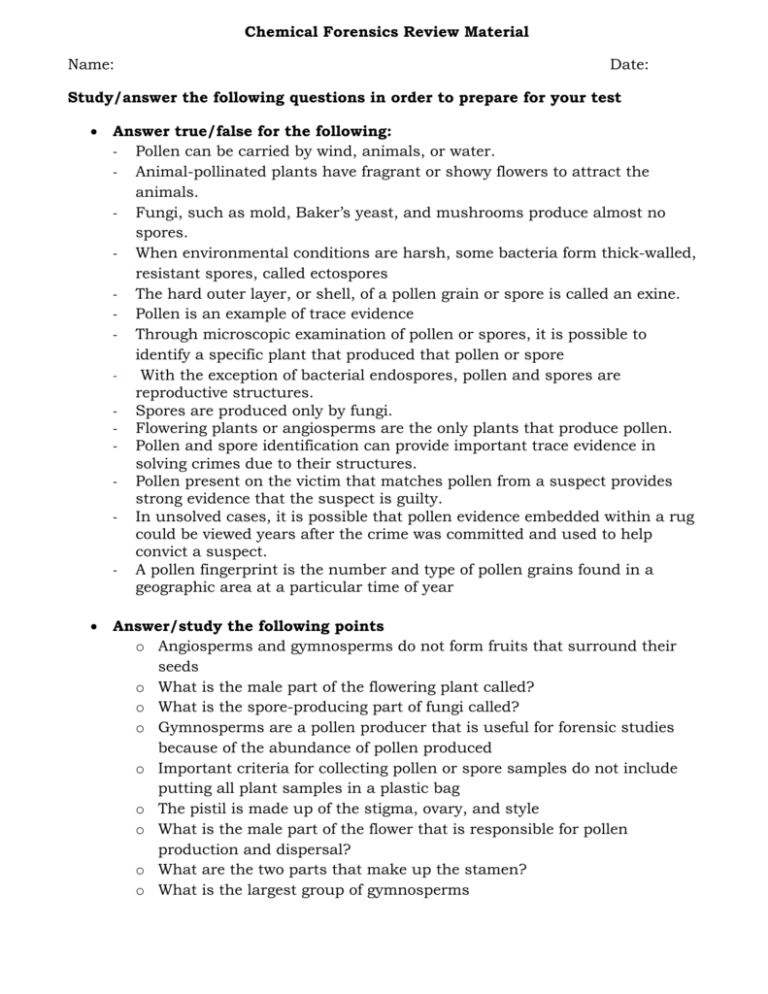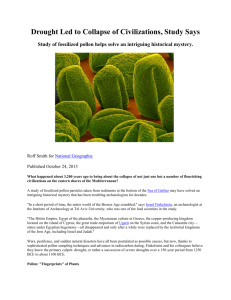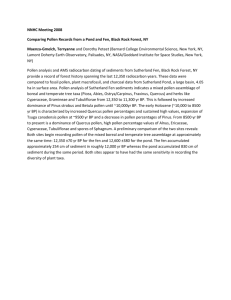Pollen Review
advertisement

Chemical Forensics Review Material Name: Date: Study/answer the following questions in order to prepare for your test Answer true/false for the following: - Pollen can be carried by wind, animals, or water. - Animal-pollinated plants have fragrant or showy flowers to attract the animals. - Fungi, such as mold, Baker’s yeast, and mushrooms produce almost no spores. - When environmental conditions are harsh, some bacteria form thick-walled, resistant spores, called ectospores - The hard outer layer, or shell, of a pollen grain or spore is called an exine. - Pollen is an example of trace evidence - Through microscopic examination of pollen or spores, it is possible to identify a specific plant that produced that pollen or spore With the exception of bacterial endospores, pollen and spores are reproductive structures. - Spores are produced only by fungi. - Flowering plants or angiosperms are the only plants that produce pollen. - Pollen and spore identification can provide important trace evidence in solving crimes due to their structures. - Pollen present on the victim that matches pollen from a suspect provides strong evidence that the suspect is guilty. - In unsolved cases, it is possible that pollen evidence embedded within a rug could be viewed years after the crime was committed and used to help convict a suspect. - A pollen fingerprint is the number and type of pollen grains found in a geographic area at a particular time of year Answer/study the following points o Angiosperms and gymnosperms do not form fruits that surround their seeds o What is the male part of the flowering plant called? o What is the spore-producing part of fungi called? o Gymnosperms are a pollen producer that is useful for forensic studies because of the abundance of pollen produced o Important criteria for collecting pollen or spore samples do not include putting all plant samples in a plastic bag o The pistil is made up of the stigma, ovary, and style o What is the male part of the flower that is responsible for pollen production and dispersal? o What are the two parts that make up the stamen? o What is the largest group of gymnosperms Chemical Forensics Review Material o The seeds of gymnosperms, the oldest seed plants, are exposed to the outside and are not enclosed in a protective chamber like the angiosperms o What are the two groups of seed plants? o What is a pollen fingerprint? o What are two different ways that spores are dispersed? o What is the difference between pollen and spores? ALL QUESTIONS FROM CHAPTER 5 These are the answers to the short answer questions 16. Wind-dispersed pollen is strong in forensic science because of the abundance of pollen produced, but less effective for determining direct links to a suspect. Animalpollinated plants are durable, making them more likely to be collected during evidence collection, but not as abundant as wind pollen. Water-dispersed pollen is not strong in forensic science because this type of pollen must stay in water or it will degrade. Pollen produced by self-pollinating plants is of low forensic value because it exists in such small numbers and is rarely encountered. 17. Certain plants need special conditions to grow and to pollinate. Country and city conditions are different. There is more air pollution in the city than in the country, and this may hinder plant cycles. The city is less conducive for plant growth because of the abundance of pavement, shade, and lack of fertile soil and water. All of these things limit the type of plants that are able to survive in that type of environment. Most plants flower during the day and not at night. This means there would be more pollen in the air during the day than during the night. 18. Soil, clothing, hair, car, furniture. 19. Microscopes, gloves, baggies, tape, forceps. 20. Sample answer: Pollen grains are microscopic and have resistant structures, unique shapes, and colors.






